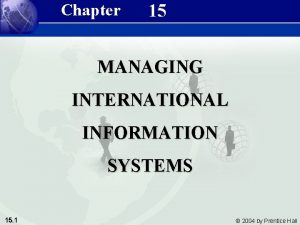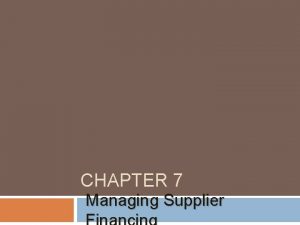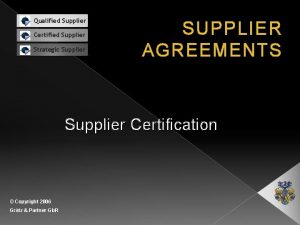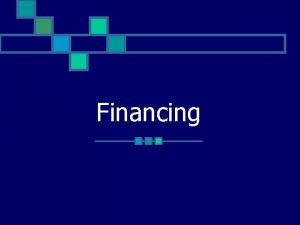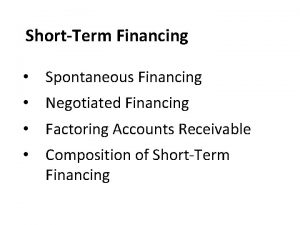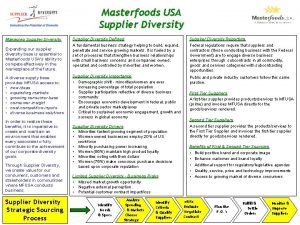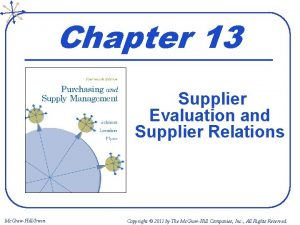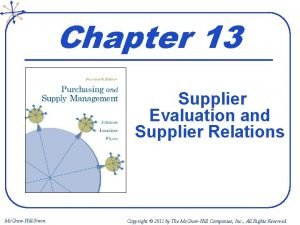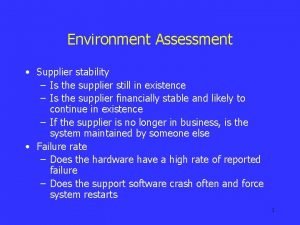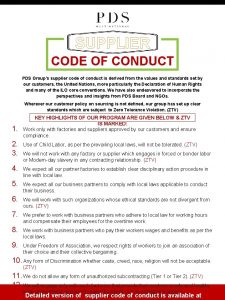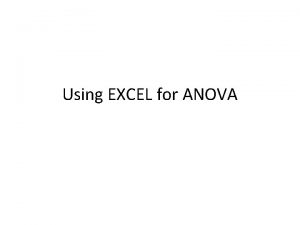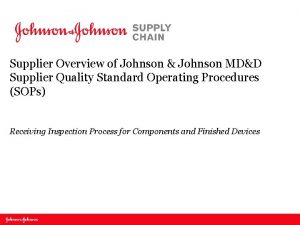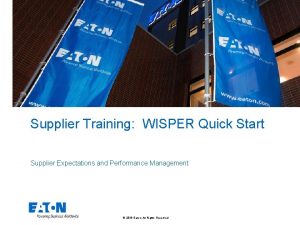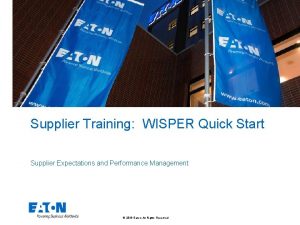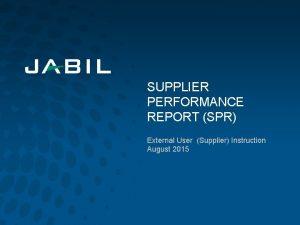CHAPTER 7 Managing Supplier Use of Supplier Financing






















- Slides: 22

CHAPTER 7 Managing Supplier

Use of Supplier Financing Accounts Payable: Refers to buyers use of supplier financing to purchase inputs needed to produce goods. Trade credit from supplier provide spontaneously generated source of financing Open Account A common credit arrangement between supplier and buyer Net Terms: Terms Supplier offer no discount but provide time for the buyer to pay. i. e. : net 30 Discount Terms: Terms Offering a cash discount for early payment. i. e. : 2/10, net 30

Types of Purchase Terms Cash in advance Cash on delivery Cash term Prox Seasonal dating Consignment

Cash In Advance (CIA)/Cash Before Delivery (CBD) Safest form of payment Payment must be received before the order is shipped. When the seller dose not want to take risk of buyer not paying Firms using CIA don’t need to run credit administration or incur bad debt.

Cash On Delivery Material shipped to the buyer, cash must be paid upon delivery. Guaranteed payment Cost of running credit admin dept. and default risk is minimized

Cash terms/ payable upon receipt of invoice Seller incur admin costs in monitoring payment and runs the risk of bad debt and delayed payments

Prox With Prox (proximate) term, all invoices dated prior to a predefined cutoff period are payable by a specified date the following month. The term 2/10, prox net 30 means the same as ‘ 2/10, net 30’ except that the 10 and 30 refer to the 10 and 30 of the next month.

Seasonal Dating For highly seasonal items Payment is due after the end of the buyer’s selling season. 2/10, net 30 dating 90 means that the time will start after 90 days from the date of invoice. Seller is able to smooth production without excessive inventory buildup.

Consignment terms Arrangement where a retailer obtains an inventory item without obligation. The seller ships the goods to the buyer who has no obligation to pay until the goods have been sold or used. If the items are not sold, the retailer can return the item without any penalty Cash flow may be delayed significantly Seller is somehow protected by retaining the title of the goods

Payables Decisions and the Cash Flow Timeline Time ==> Purchase Date Cash Discount Date Credit Period

Basic Principles Never pay early, pay on the last day of: the discount period, or the credit period Take a cash discount when: Annualized discount rate > Annualized borrowing cost (opportunity rate) Stretch only as a last resort, not as a policy

Payment Decision Model When days delayed ≤ discount period (Taking discount) When days delayed > discount period (Credit period) When days delayed > credit period (Stretching)

When Days Delayed ≤ Discount Period PV = - _ IP x (1 -d)_____ [1 + (DD)×(k/365)] where, PV: Present Value of the Purchase IP: Invoice Price DD: Days until payment is made d: Discount percentage received if paid during discount period k: Annual opportunity cost

When Days Delayed > Discount Period PV = - Where, IP DD k IP_____ [1 + (DD)×(k/365)] = Invoice Price = Days Delayed = Cost of capital

When Days Delayed > Credit Period PV = - Where, IP f DD k IP x (1+f) ---------------[1+ (DD)×(k/365)] = Invoice Price = Late fee = Days Delayed = Cost of capital

Take or Leave a Discount KTC = d__ × __365 _ (1 -d) (CP-DP) Here, k. TC: Annualized cost of trade credit d: Discount percentage taken if paid before discount period expire DP: Days until discount period ends CP: Days until trade credit period ends

Monitor the Use of Supplier Financing A payment policy can be formulated once buyer receives trade credit terms from supplier. üThe next step is to monitor the execution of the policy to reduce likelihood of losing cash discount or paying late. ü The Balance Fraction Method Days Payable Outstanding

Balance Fraction Approach

Balance Fraction Approach (Cont. )

Monitoring the A/C Payable balance

Monitoring the A/C Payable balance (Cont. ) Januar y Februar y March April May June 100 120 100 80 60 70 68 55 42 44 Average Daily Purchases (quarterly) 3. 56 3. 33 2. 67 2. 33 DPO 19. 1 16. 5 15. 8 18. 9 Purchases Ending Payables

Accruals Definition an expense that has been incurred but has not yet been paid Two basic types accrued wages and salaries accrued interest and taxes
 Chapter 8 financing a business
Chapter 8 financing a business Chapter 1 managing risk when driving
Chapter 1 managing risk when driving Chapter 8 managing stress and anxiety
Chapter 8 managing stress and anxiety Chapter 4 managing stress and coping with loss
Chapter 4 managing stress and coping with loss An example of a biomechanical distraction is
An example of a biomechanical distraction is Chapter 8 managing distractions answers
Chapter 8 managing distractions answers Chapter 6 managing weight and body composition
Chapter 6 managing weight and body composition When you apply the ipde process
When you apply the ipde process Use the ipde process chapter 5
Use the ipde process chapter 5 Chapter 4 lesson 2 managing stress
Chapter 4 lesson 2 managing stress Chapter 4 managing risk with the ipde process
Chapter 4 managing risk with the ipde process Managing in a global environment
Managing in a global environment Chapter 18 managing anxiety
Chapter 18 managing anxiety Chapter 17 managing business finances
Chapter 17 managing business finances Chapter 17 managing business finances
Chapter 17 managing business finances Chapter 16 managing the stress in your life
Chapter 16 managing the stress in your life Managing medical records chapter 13
Managing medical records chapter 13 Why should teen athletes avoid performance enhancers?
Why should teen athletes avoid performance enhancers? Chapter 11 lesson 1 maintaining a healthy weight
Chapter 11 lesson 1 maintaining a healthy weight Managing global systems chapter 15
Managing global systems chapter 15 Managers and management chapter 1
Managers and management chapter 1 Chapter 11 managing weight and eating behaviors
Chapter 11 managing weight and eating behaviors Managing in a global environment chapter 4
Managing in a global environment chapter 4



















